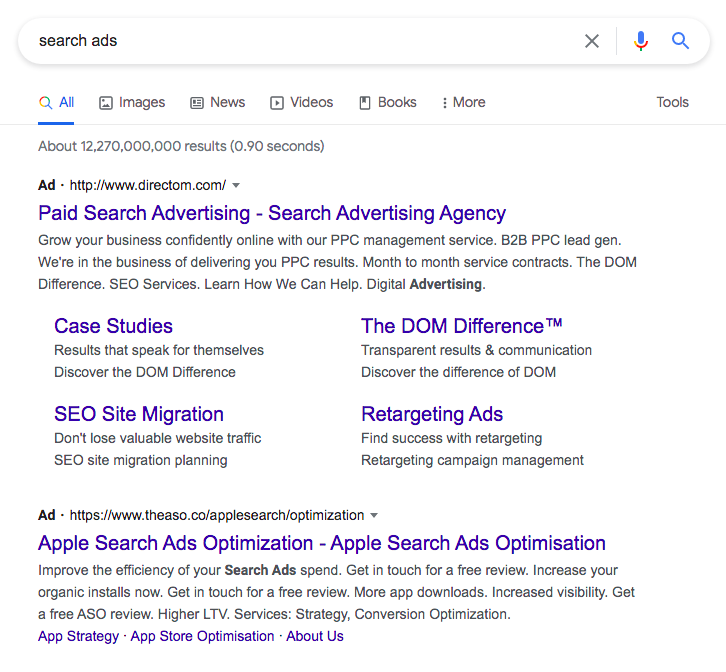Last Updated: July 15, 2023
PPC campaign management is an essential part of a digital marketing strategy. In this article, we’ll discuss everything you need to know about Google Search Ads.
What Are Google Search Ads?
A search ad is an ad that shows up within a search result. Here is how an ad looks like within a search result:

As you can see from the screenshot above, the results shown for the search ‘search ads’ have an ‘Ad’ written right next to the URL. That is the way for users to tell the difference between a Google Search Ad and an organic listing.
Advantages of Google Search Ads For a Business
Higher Intent
Your ads show up in search results, where there is higher intent. That’s because if a user is actually making an effort to search for something, they are much more likely to convert.
Better Quality Traffic
Due to the higher interest in the topic, the quality of traffic coming from a search result is much higher than what you would find from a Google Display campaign with similar targetting.
More Conversions
With better quality traffic with high intent coming to your website, you will see a higher conversion volume.
Increased Presence on Keywords
Can’t get visibility on non-brand keywords organically due to competition? Then PPC campaigns are a great way to capture attention.
Things to Keep in Mind
While there are multiple advantages of search campaigns in Google, it is important to keep in mind that Google’s best practices must be followed for optimum results. For example, it is important to have a correlation between the ad copy, keyword targeting, and the landing page that the ad takes the user to. That’s because, if there is not a correlation, the user is not getting the best experience from Google’s search engine, which is something Google does not want.
Read Also: Avoid These Common Mistakes While Setting Up Google Search Ads

Google Ads KPIs
When it comes to measuring the success of your PPC campaigns in Google Ads, there are several key metrics and KPIs that provide valuable insights into campaign performance and effectiveness. Here are some essential metrics to consider:
Impressions
Impressions refer to the number of times your ads are displayed to users. Monitoring impressions helps you gauge the reach and visibility of your campaigns.
Clicks
Clicks represent the number of times users click on your ads. This metric indicates the level of interest and engagement your ads generate.
Click-through Rate (CTR)
CTR measures the percentage of users who click on your ads after viewing them. It is calculated by dividing the number of clicks by the number of impressions. CTR provides insights into the relevance and effectiveness of your ad copy and targeting.
Cost
Cost represents the total amount spent on your PPC campaigns. It helps you understand the financial investment required to achieve your marketing goals.
Cost per Click (CPC)
CPC is the average cost you pay for each click on your ads. It is calculated by dividing the total cost by the number of clicks. Monitoring CPC allows you to optimize your bidding strategy and manage your budget efficiently.
Conversions
Conversions refer to the desired actions taken by users after clicking on your ads, such as making a purchase, submitting a form, or signing up for a newsletter. Tracking conversions helps you evaluate the effectiveness of your campaigns in driving desired user actions.
Cost per Acquisition (CPA)
CPA measures the average cost incurred to acquire a customer or achieve a specific conversion goal. It is calculated by dividing the total cost by the number of conversions. Monitoring CPA enables you to assess the efficiency of your campaigns and optimize your budget allocation.
Conversion Rate (CVR)
Conversion rate measures the percentage of users who complete a desired action out of the total number of clicks. It helps evaluate the effectiveness of your landing pages and the overall campaign in driving conversions.
Return on Ad Spend (ROAS)
ROAS measures the revenue generated for every dollar spent on advertising. It is calculated by dividing the total revenue by the total cost. ROAS helps you assess the profitability and effectiveness of your PPC campaigns.
By analyzing these metrics and KPIs, you can gain valuable insights into the performance of your Google Ads campaigns. This data empowers you to make informed decisions, optimize your campaigns for better results, and achieve your marketing objectives more effectively.
Read the latest tips about PPC campaign management online at ShiruDigi’s digital marketing blog. For regular updates, follow us on Facebook, Instagram, YouTube, and LinkedIn.
Looking for a Digital Marketing Agency?
At ShiruDigi, we’re a team of digital marketing experts with practical industry experience. Whether your brand’s monthly budget is $5000 or $5 million, we know exactly how to create a PPC campaign management strategy that’ll give give you a bang for your buck! Learn more about our PPC campaign management services and contact us today for a free 30 minute business consultation.

Comments are closed